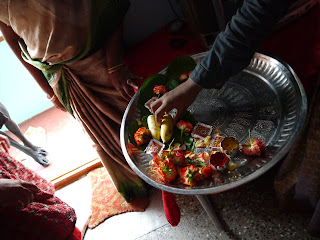


As I see Claudia drive off on her way to the Bangalore airport, the first leg of her 24-hour journey home to the Philippines, I am trying to recall the yamas, particularly aparigraha or non-attachment. I so want to be cool about all this.
Still, it’s hard to see Claudia go. I feel it in my chest and in my clouding vision. We set off on this journey together, deciding back in January the exact date, filling out our KPJAYI registration forms in June, and taking the trip together here a month ago to the date.
I remember when Claudia first came to class, nearly 3 years ago. She was a tourist then on Boracay. Her and her husband Deivis were probably the most advanced practitioners us beginners had seen. Up to that moment, I’d only been up to navasana. I was totally unaware that there was actually more. A lot more! Our yoga teacher stopped the rest of us and had them continue. It was awesome and inspiring.
When her family returned the following year, permanently, it was a total blessing. The universe provided me with a knowledgeable practice partner, spurring me to get on the mat in the morning for self-practice.
To experience this month with her here in Mysore, taking classes at the shala, living together and supporting each other throughout the motions has been incredible. I feel so blessed to have a friend here that I get on so well with, who is so easy to live with, who is even-minded and grounded. I am so grateful.
The last week was perfect, easier going than the previous weeks. The manic-ness of settling in, seeing sights and shopping died a natural death. We ate at all the favored breakfast nooks, had our lunch thali, and finally ate Thursday Taiwanese lunch buffet at Viviane’s.
Yesterday’s led was the first day we didn’t practice in the same class. I got bumped up to a 5:30am start when I re-registered for month two, which means I practice with the 4:30am group on Friday. A prelude of the fast-approaching future, the change foiled our plans to get up early and stake out near the entrance so we could get a spot beside each other during the led class.
(Claudia's class turned out to be a historical moment at the shala. Claudia told me when she got home that Sharath led the opening prayer then quite off-handedly turned the floor over to Todd, an advanced student and yoga teacher, who led the class. It is the first time a westerner led a class in the shala. Sharath had a puja to attend during the class but was back by closing prayer. Todd had led them in "Om..." then paused, causing many students to wonder if after the entire thing he had forgotten the closing prayer. Turns out Sharath would finish it off. Claudia said it was a great class too! Todd was applauded for his efforts by everyone in the shala. I got goosebumps when Claudia recounted the story. These are certainly times of change! Positive ones, I feel).
We enjoy a good Indian breakfast at Sri Durga after Claudia’s class. Take a leisurely trip into the city to hunt down some recommended Bollywood titles at Sapna’s bookstore, then have tea and cake at the picturesque Green Hotel before going to kirtan with James in Gokulam.
We decide to cap the monster day by dragging Jaja (a friend from China, whom we met in Boracay) to meet other friends at 6th Main for dinner. For KPJAYI students this makes for a wild Friday night: dinner after 7 and more than one cup of chai after 8! Wired, we are all glad there is no practice on Saturday!
At home, Claudia and I throw caution to the wind and share a bar of chocolate. (From Truppti’s!) She has a surprise for me, a hand-painted bookmark, another bar of chocolate (my favorite too, dark chocolate with peanut butter), and a clay Ganesh that she also painted herself, under the guise that it was a present for Deivis-—In hindsight, I did find the hot pink and shiny orange a strange color choice for her kite-boarding husband!
“The remover of obstacles,” she said.
So for the last time, in our extremely comfortable Gokulam living room, we laugh and chat about our month-long experience. She gives me a good farewell pep-talk, reminding me to conserve my energy and to keep focus (she knows me so well!) Like a big sister, she checks up on my headspace, making sure I maintain a healthy perspective—that I don’t get caught up, that I simply enjoy the practice. I will so miss her steadiness!
In the morning, after a good lay in, we head to Anouki’s—the designated farewell breakfast. Friends who started at the shala around the same time as us gather round the table. It’s one of those long, lingering dos. Lots of laughs, exchanging of photos, email addresses. Continuously, Claudia is being accosted for not having a facebook account.
Instead of goodbyes, there are a lot of “see you later,” attached with the hope that it will be here, same place, sometime next year. Saying that makes us all feel better, that returning here in Mysore with all these brilliant and loving people is something that we can all look forward to!
























